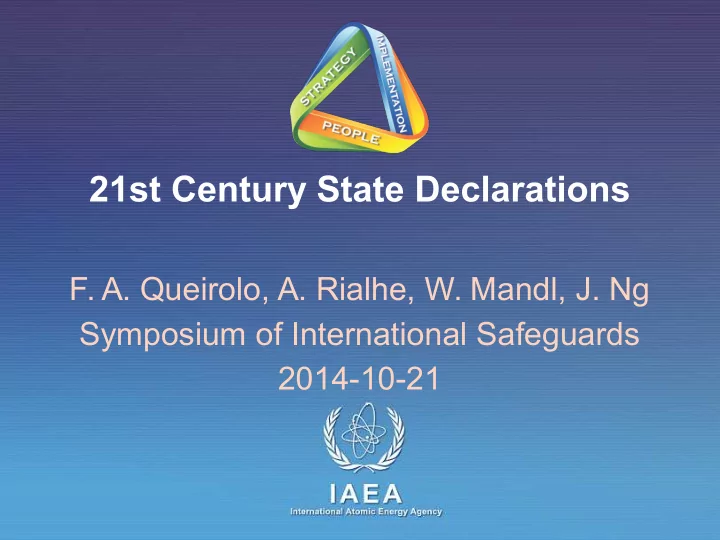

21st Century State Declarations F. A. Queirolo, A. Rialhe, W. Mandl, J. Ng Symposium of International Safeguards 2014-10-21 IAEA International Atomic Energy Agency
Purpose of this presentation Provide SGIM’s perspective on modernizing the transmission and processing of State submissions. Including: • Current transmission methods and areas for improvement • SGIM conceptual requirements • Current IAEA-SG IT landscape overview • Future outlook IAEA
Background • SGIM: “The Backbone for State Declared Information Management and Analysis” • Manages State declarations which are submitted in multiple forms and mediums • Increasing volume of State reporting • Expanding amount of unstructured information (e.g. Additional Protocols, Small Quantity Protocols, etc.) IAEA 3
SGIM – The Department’s Clearing House The Department’s Centre for State Declared Information SQP 2005 Inventories 1998 NAMIS 1997 Trafficking DB 1997 Additional Protocol 1993 Voluntary Reporting Scheme 1974 Import/Export Notifications (INFCIRC/207) 1971 NPT Nuclear Material Accounting (INFCIRC/153) 1968 Non-NPT Nuclear Material Accounting (INFCIRC/66) IAEA NAMIS = Np Am Monitoring Information System
Stakeholders • SRA*: submits declaration, provides clarifications, responds to questions, resolves omissions • SG (including SGIM): intake, processing, analyzing, inspections • IAEA non-SG (ARMS): Processes a copy of the State declaration *SRA - State or Regional Authority responsible IAEA 5 for safeguards implementation
Current Transmission Methods Declarations are currently transmitted via: • Encrypted email sent to IAEA • Physical Transfer- hand carried by inspectors or State representatives to IAEA: digital media or paper • Post- mailed via post/package delivery company (e.g. DHL): digital media (CD, USB), or paper • Fax: “hard copy that is hard to read” IAEA 6
Current Transmission Paths IAEA
Current Site Plan path to SG IAEA 8
Current Issues with All Transfer Methods • Labour intensive process • All declarations require some level of formatting/QC before inputting into our DB • Acknowledgement processes is paper based • Security/Confidentiality Overhead • Paper: ARMS/SG • Electronic: Encryption/Certificates • Languages (UN has 6) IAEA 9
Issues with current mediums of transfer • Paper declarations • Completely manual entry • Additional work for non-text • Confidentiality Overhead (ARMS SG) • Legibility (faxes) • Tracking • Electronic declarations • 1-way communication • Varied file formats and standards IAEA 10
Desired Functionality • 2-way communication • SRA submits State declaration and can respond to requests for clarification • IAEA-SG acknowledges receipt and can request clarification • Automatically perform basic QC • Required & data validation • Alerts SRA user of potential errors, and allows corrections before submission IAEA 11
Desired Functionality (cont.) • Security • As required user accounts for SRA users • User/password administration for SRA and IAEA-SG admin • Backwards compatibility and interoperability • SRA contact list IAEA 12
Desired future workflow IAEA
Landscape - IT Security • Connections to SG are only permitted from inspectors laptop (VPN) or IAEA equipment to the SG LAN (or DMZ in special cases) • All State declarations will reside on ISE (a secure network) • ISE and Information Classification policies are being updated IAEA 14
Landscape – IT Infrastructure • Agency-wide LAN: SG Confidential data and above could not reside there (SPRICS 2.0) • SG-LAN: non IAEA-SG equipment can not access it (remote monitoring equipment) • “Member State Data Submission Hub” (MSDSH) – conceptual stage Strong consideration will be given to re-using existing SG services and integration of States components IAEA 15
Conclusions • Need for modernization has been recognized and there have been primarily individual efforts to date • IAEA SG is looking for an extensible unified solution which is compatible with existing State NMAC* systems • Collaboration with States is necessary for project scoping, funding, requirements gathering, and integration *Nuclear Material Accounting and Control IAEA 16
Recommend
More recommend